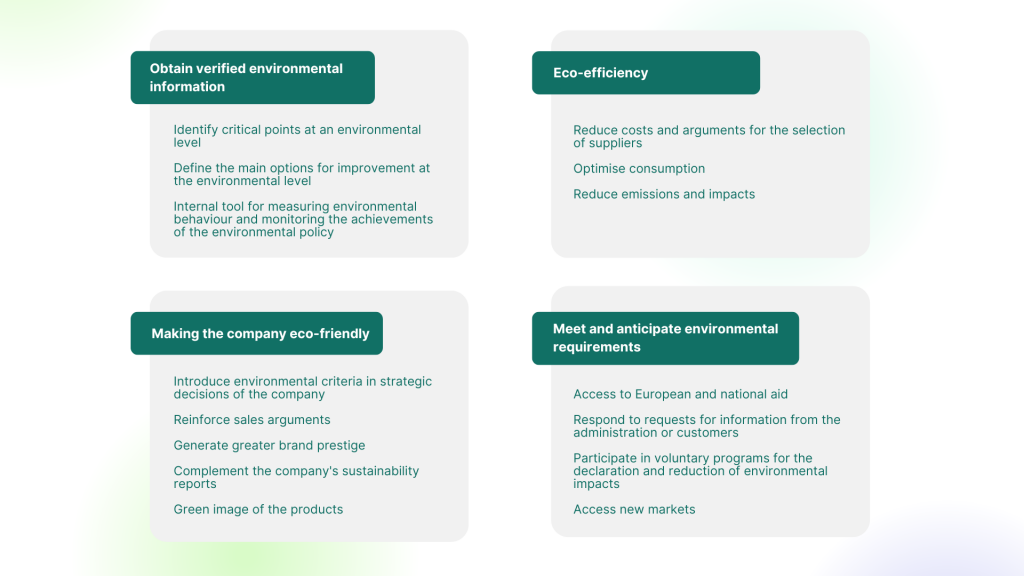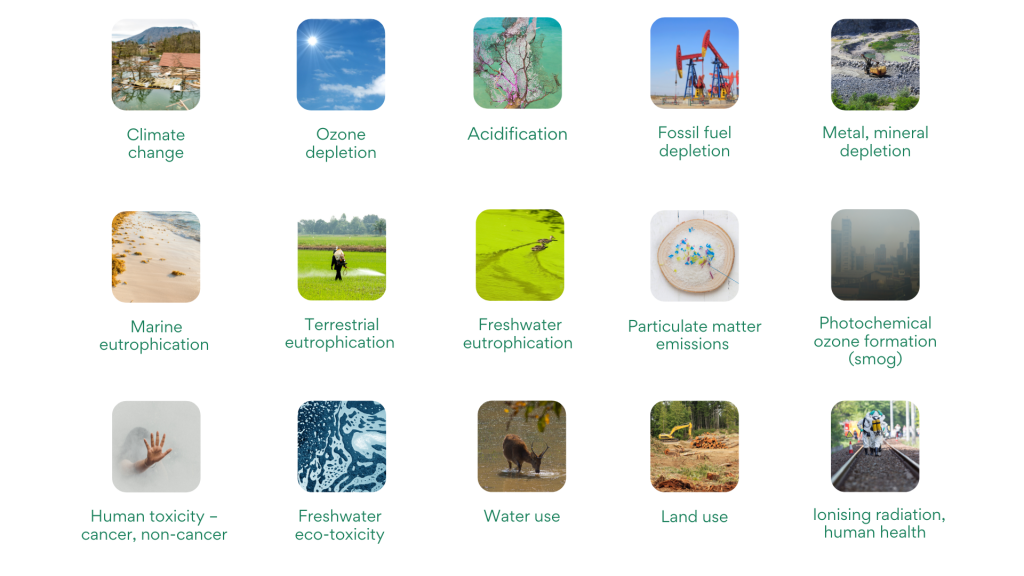Calculating the environmental footprint is a fundamental way to measure, monitor and improve the impact we have on the planet. This key step makes it possible to identify risks for the organisation and for society, which means that more and more organisations partake in disclosing their environmental performance. In 2019, more than 600 Spanish companies registered their environmental footprint with the Ministry of Ecological Transition. Although there is no current obligation to report on the impact on the environment globally, large companies such as H&M or Nestlé have asked that the disclosure of the impact on nature be mandatory in 2030.
In this article, we elaborate on what exactly is the environmental footprint and how it is classified and measured.
What is the environmental footprint?
The environmental footprint , also known as the ecological footprint, measures the impact of people or organisations on the environment, whether it is positive or negative. In the case of organisations, it is defined as a multi-criteria measure of the environmental performance of their activity when providing goods or services, taking into account the entire life cycle .
It is crucial that companies measure their impact on the environment in order to correct their negative externalities.There is therefore a constant push for short, medium and long-term objectives to be established. In addition, these goals must be extended to the entire business ecosystem, including workers, investors and customers.
Organisation environmental footprint (OEF)
The OEF is the result of applying the above to the business environment. The European Union proposes a standard methodology that calculates the OEF based on the life cycle analysis (LCA) to quantify the environmental impacts of organisations (companies, public administrative entities and other bodies). Regarding the scope of the OEF, the following is estimated:
The OEF boundary includes all indirect activities and associated impacts. Indirect activities are those that occur upstream or downstream along the supply chains linked to organisational activities. The OEF boundary shall, by default, include all stages from raw material acquisition through manufacturing, distribution, storage, use and end of life treatment of the product portfolio (i.e. cradle to the grave)
Source: European Comission
In addition, the European Commission recently reinforced the concept of «due diligence» in companies, highlighting the importance of having a transparent supply chain and business model. The intention is that they contribute to keeping the increase in the average temperature of the planet below 1.5 °C and that the human rights of workers are respected, applied to European companies that operate both inside and outside the Union.
OEF Benefits
This concept represents a fundamental advance in the fight against climate change and the degradation of ecosystems , since it clarifies the role that businesses have, regardless of their size. Moreover, there are the following advantages:
- It allows the development of better ESG policies.
- It facilitates the reduction of the carbon footprint in the business environment.
- It contributes to mitigating the impact of economic activities on ecosystems.
- It is an additional way to comply with that which is required by the ISO 14040:2006 technical standard .
- It promotes the life cycle analysis methodology in relation to products and services.
According to the analysis of Basque Ecodesign Center, the advantages of calculating the corporate environmental footprint are based on four main axes:

Product environmental footprint (PEF)
Another feature of the environmental footprint is that it can also be focused on the production of a company. In this sense, it is necessary to know what is the impact that the commercialisation of each product has. This is perhaps the most relevant method since it constitutes the basis of the business.
For your analysis to be effective, you need to focus on the following aspects :
- Generation of the initial idea
- Search and obtaining of raw materials
- Product development
- Transformation into service or sales experience
- Marketing and advertising process
- Direct to consumer sample and sale
- Traceability and post-sale
Types of environmental footprint
The environmental footprint is associated with several indicators. These classifications serve to know what potential each process has to reach the planetary limit, both in the local and global sense. In essence, there are six types that have emerged as a result of the application of the previous aspects to the business world.
The water footprint
It measures the volume of fresh water used for the production of a good or the granting of a service. It must be complemented with what the consumer requires to enjoy the product.
The footprint of climate change
Corresponds to GHG emissions (greenhouse gases) resulting from business activity. In other words, it determines the contribution to the destruction of the planet’s ozone layer.
The resource footprint
Shows the consumption of natural resources in the generation of products or services. According to the Global Footprint Network, the amount of resources that the world should aim to use annually had already passed its limit by the end of July.
The atmospheric footprint
This is the ability of a product to harm the atmosphere through the emission of polluting gases or the degradation of forests.
The waste footprint
It discloses the contamination that a product or service supposes to the natural environment. For example, the spilling of fuel into the oceans or the accumulation of non-biodegradable materials in the seas.
The footprint of biodiversity
Corresponds to the negative impact of economic activity on ecosystems, mainly terrestrial and marine. The expulsion of waste or the indiscriminate felling of trees are direct causes.
How to measure the environmental footprint of your company?
In order to achieve a detailed analysis, different ways of measuring the corporate environmental footprint have been proposed . The following steps form the simplest method for any sector.
1. Identify environmental aspects
It is essential to know the relationship of each process with the environment by following the subsequent standards:
- Guide to the environmental footprint of organisations: presented with recommendation 2013/179/EU of April 9, 2013 of the European Commission.
- ISO/TS 14072:2014 standard environmental management: Life cycle assessment; requirements and guidelines for organisational life cycle assessment .
- Guidance on organisational life cycle assessment .
2. Categorise the environmental impact
The environmental impact of each process must be classified . To do this, this impact must be divided into positive and negative and, for a more detailed analysis, assigned a metric. The carbon footprint is usually the most appropriate, as it is recognized by the United Nations. Generally, 15 categories are considered:

However, the lack of consensus on the area of impact for biodiversity makes this process difficult. In that sense, the Task Force on Nature-Related Financial Statements (TNFD) aims to put nature at the centre of business considerations.
3. Collect data for environmental footprint
Collecting as much data as possible is essential for the report to be conclusive. A highly recommended guideline is to carry out an external audit for this matter.
How to write a corporate environmental footprint report?
According to the EU recommendations, an OEF report must contain at least these aspects.
Definition of the objectives of the OEF study
First of all, it is extremely important to clearly define what the objectives of determining the OEF are. The most common are related to:
- Comply with the criteria of the ISO 14001:2015 standard
- Establish it as a decision-making method
- Move towards the neutral footprint in every direction
Definition of the scope of the study
The term “scope” is perhaps the most complex to define in a OEF report . It should be interpreted and exposed in the following ways:
- Entities and organisations that have been analysed.
- Methodologies and commercial phases under review.
- National or international extension of the analysis (depending on the size of the company).
Compilation of the inventory of resource use and emissions
Generally, this phase is divided into several groups:
- Group A is usually related to the primary impact: land occupation, GHG emissions, etc.
- Group B is the secondary impact: use of vehicles, manufacturing and marketing processes, among others.
- Group C is linked to the tertiary impact: contamination by suppliers, acquisitions…
Environmental impact evaluation
This is the most important part, as you need to assess what the environmental impact has been during the year. For this purpose, the above criteria (processes of three groups) must be exposed together with a result to which a metric can be applied such as:
- PUE : energy efficiency in the use of ICT tools.
- CUE : efficiency in the use of carbon and fossil fuels.
- WUE : Efficiency in the consumption and use of freshwater.
Data interpretation
The interpretation of data is usually comprised in the conclusions of the report. After assessing the three previous groups, it is convenient to explain the company’s perception of the results. This impression can be divided into certain additional criteria that will serve to draw short and long-term strategies :
- Introduction of improvement proposals.
- Comparison with previous years.
- Setting new goals.
- Link to new technical standards.
- Submission to control entities.
In short, the environmental footprint is a strategy that allows companies to be linked to the fight against climate change. The time has come to strengthen the commitment to a greener planet. Do not hesitate to start calculating your organisation’s environmental footprint. Contact us!
Subscribe to our resource hub to keep up to date with the latest trends in the sector








